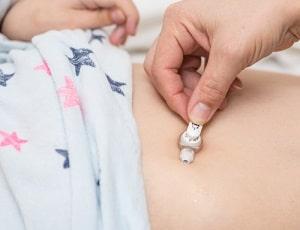Chicago, IL 60601
FREE CONSULTATIONS 312-462-4200
TOLL FREE 833-462-4200
Will My Child With Cerebral Palsy Need to Use a Feeding Tube?

If your child suffers from cerebral palsy, you will want to understand how you can provide the best care for your son or daughter. One issue that parents may be concerned about is whether their child will need assistance with feeding and nutrition. Studies have found that within their first year of life, 57 percent of children with cerebral palsy have problems with sucking, and 38 percent have problems with swallowing. In addition, over 90 percent of children with CP have significant oral motor dysfunction. Because of these issues, children may require intervention to ensure they receive the proper nutrition, and in some cases, a feeding tube may be necessary.
G-Tube Placement
Feeding tubes that deliver food and liquids directly to a child’s stomach are known as gastronomy tubes or G-tubes. A surgical procedure will be performed to create an opening known as a stoma in the abdomen and the wall of the stomach, and the tube will be inserted through this opening. A child will usually be placed under general anesthesia during this type of surgery. Depending on the child’s needs and whether other surgical procedures need to be performed at the same time, laparoscopic techniques may be used to insert the tube through small incisions, or open surgery involving larger incisions may be necessary.
Gastronomy Feeding and Management
A G-tube may be used to meet all of a child’s nutritional needs, provide hydration, and administer medications, or it may be used as a supplement to what the child is able to eat and drink orally. As a child grows and develops, occupational therapy and other forms of treatment may help him or her eat and drink without the need for assistance, and a G-tube may be removed if it is no longer necessary.
Children may experience a variety of complications following G-tube placement surgery. Parents should be aware of potential risks and be sure to follow the correct procedures when administering nutrition or medications and cleaning the area around the tube. In some cases, leakage or irritation may occur, and steps should be taken to prevent infections. Parents should notify their doctor if a feeding tube becomes dislodged or blocked or if their child experiences symptoms such as excessive bleeding, severe abdominal pain, vomiting, diarrhea, fever, or swelling or redness in the skin around the tube.
Contact Our Chicago Cerebral Palsy Birth Injury Attorneys
Caring for a child with cerebral palsy can be challenging, and parents will want to make sure they are taking the right steps to meet their child’s needs. The costs of surgical interventions and ongoing treatment can be high, but financial assistance may be available to help parents provide the proper care. At the Birth Injury Law Alliance, we can help you determine your options for receiving financial help, including pursuing compensation for birth injuries that resulted in CP. Contact our knowledgeable and compassionate Illinois birth injury lawyers today at 312-462-4200 to arrange a free consultation.
Sources:
https://effectivehealthcare.ahrq.gov/products/cerebral-palsy-feeding/research-protocol
https://kidshealth.org/en/parents/g-tube.html
https://together.stjude.org/en-us/diagnosis-treatment/procedures/feeding-tube-placement-for-enteral-feeding/placement-gastrostomy-g-gastro-jejunostomy-gj-jejunostomy-j-tubes.html





